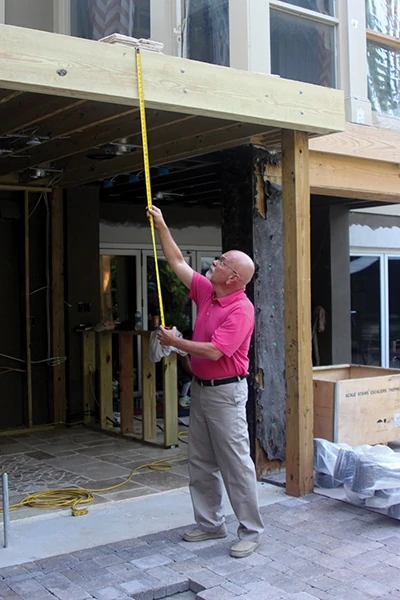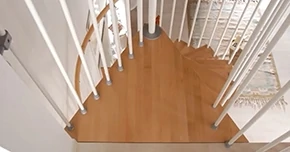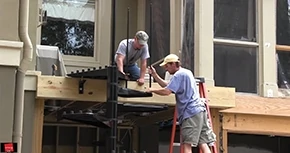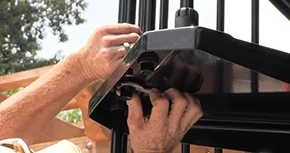Modular kits make design and installation easy for the DIY’er.
Adding a traditional spiral staircase can be an intimidating project for a homeowner, because the stairs are professionally custom-built to exact specifications, and everything must fit correctly or there will be problems with the installation. Furthermore, the custom manufacturing process accounts for a large part of the typical 6 to 8 weeks lead time required by most spiral-stair companies.
Arke Stairs takes an entirely different approach to spiral stairs. The company offers a modular “staircase in a kit” that the homeowner designs online with a simple step-by-step web-based tool at arkestairs.com. Once you’ve determined your staircase style, your exact height measurement, the directional turn of the spiral, and the size/type of your landing, Arke assembles a kit to fit your needs and ships it to arrive within 7 working days, ready for installation even by a do-it-yourselfer.
Five-step Selection Process
When ordering a spiral staircase kit, the first step is to decide whether or not it’s an indoor or outdoor installation.

Step Two is to measure from the finished floor on the top level to the finished floor on the bottom level of the proposed stair location. This determines the exact height required for the installation.


Step Three is to measure the total amount of space you have available to determine the correct diameter of the stair. The company recommends that the available finished space is at least two inches greater than the total diameter of thespiral staircase or total width of the modular staircase. This allows for clear passage of the handrail and eliminates a “pinch point” of the handrail against a wall or upper floor opening.


Step Four: Decide between metal treads and wooden treads. Arke offers both.
Step Five: Choose your color. Arke offers the choices of a high-gloss black, high-gloss white or a satin gray.


Once you have this information in hand, you can visit Arke’s online selection tool. The company’s sales and support team can also assist you in purchasing the right stair kit for your needs.

Unique Features for Easy Installation
For the do-it-yourself installer, Arke spiral stairs come with three innovative design features that address the major problems which usually make installation a contractor job.


Adjustable height. Rather than rely on an exact height measurement, Arke stairs are adjustable in height through the use of a patented spacer system. The standard spiral kit is adjustable in height from approximately 8 ft.-3in. to 10 feet. For heights above 10 feet, additional risers and center pole extensions are available.


Directional turn of the spiral. Most manufacturers produce a specific unit based on the rotational turn (clockwise or counterclockwise) of the spiral for specific installation. This requires careful planning and measurement to avoid a restricted or blocked floor exit. The standard Arke kits are designed to make a complete 360-degree turn. Therefore, the first step will be directly underneath the landing. However, by adding or subtracting risers the rotation will change by approx. 30 degrees per riser. Furthermore, Arke spiral stairs can be turned in either clockwise or counterclockwise, which greatly minimizes the chance of error in the order and installation.


Landing size and type. For the landing at the top of the stairs, most manufacturers produce a specific design for the planned installation, either a mezzanine, round or square landing area. Arke’s premiere interior kits, the Phoenix and the Civik models, both offer a patented universal landing as a standard feature. This provides greater flexibility and easier installation.
Installation & Assembly
Once the kit has been designed and shipped to the home, the Arke staircase kit is a do-it-yourself project that can easily be installed by the homeowner with common household tools. Most installations can be accomplished in a single day.
Attach the landing to the finished floor with the included hardware.

Each model contains all the necessary components and detailed assembly instructions as well as a DVD. You can preassemble parts of the base, treads and balusters prior to incorporating them into the staircase. Careful measurement of the floor-to-floor height will help you determine the required number of spacers and their proper placement.


Mark on the floor the center of the opening, then position, drill and fasten the base with the included hardware. Screw the center pole into the base, insert the base-plate cover and then add the treads and spacers according to the kit’s instructions.
When you reach the end of the pole, join the second section of pole with the included hard-ware and proceed up the pole with the remaining treads and spacers.
After having chosen the stair rotation, position the landing on the arrival side of the treads and fasten in place according to the kit’s manual.


You can then spread out the treads fan-like, making it possible to use the stair. Starting from the landing, insert the longer railing balusters that build the connection between the treads. Be careful to keep them in a vertical position. All the hardware to assemble the baluster system is included with the kit, and the handrail installs over the balusters with the same corresponding curve of the staircase. Check your kit’s literature for further installation details, which may vary somewhat from model to model.


DIY Friendly
For a do-it-yourselfer who wants a spiral staircase, you’re unlikely to find a more user-friendly solution than Arke’s “staircase in a kit.” Rather than waiting 6 to 8 weeks for a custom unit and paying for expensive professional installation, the Arke kits come as all-in-one complete units. All treads, landing, balusters, handrails, hardware and accessories are included. The kits are in stock for immediate delivery, plus there’s nothing to paint, weld, stain or seal.
Side Note
Building Code Requirements
Ultimately the question of code compliance for a spiral staircase is a local matter. A municipality may have its own specific requirements. Local building inspectors and code compliance officers often have different interpretations of the International Residential Code (IRC), International Building Code (IBC), or the older ICBO, CABO or SBCCI codes. It is the homeowner’s responsibility to consult with the local building inspector or code compliance officer for information with respect to local code requirements.




